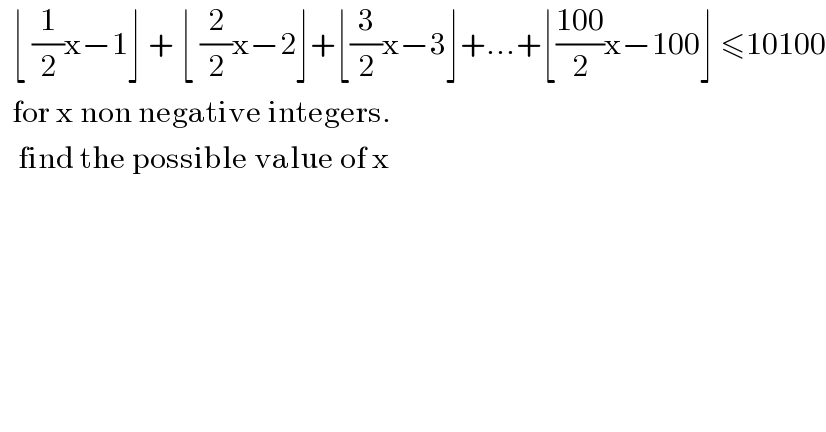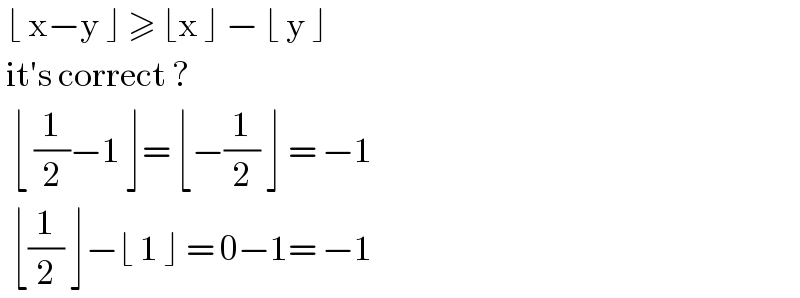
Question Number 213423 by efronzo1 last updated on 05/Nov/24

$$\:\:\lfloor\:\frac{\mathrm{1}}{\mathrm{2}}\mathrm{x}−\mathrm{1}\rfloor\:+\:\lfloor\:\frac{\mathrm{2}}{\mathrm{2}}\mathrm{x}−\mathrm{2}\rfloor+\lfloor\frac{\mathrm{3}}{\mathrm{2}}\mathrm{x}−\mathrm{3}\rfloor+...+\lfloor\frac{\mathrm{100}}{\mathrm{2}}\mathrm{x}−\mathrm{100}\rfloor\:\leqslant\mathrm{10100} \\ $$$$\:\:\mathrm{for}\:\mathrm{x}\:\mathrm{non}\:\mathrm{negative}\:\mathrm{integers}. \\ $$$$\:\:\:\mathrm{find}\:\mathrm{the}\:\mathrm{possible}\:\mathrm{value}\:\mathrm{of}\:\mathrm{x} \\ $$
Answered by golsendro last updated on 05/Nov/24

$$\:\:\:\underline{ } \:\: \\ $$
Commented by hardmath last updated on 05/Nov/24

$$\mathrm{thankyou}\:\mathrm{dearprofessor} \\ $$
Commented by mr W last updated on 05/Nov/24

$${when}\:{A}\leqslant{B}\:{is}\:{given}\:{and}\:{you}\:{get} \\ $$$${A}\leqslant{C},\:{how}\:{can}\:{you}\:{then}\:{say}\:{C}\leqslant{B}, \\ $$$${not}\:{B}\leqslant{C}? \\ $$
Commented by mr W last updated on 06/Nov/24

$${how}\:{can}\:{you}\:{go}\:{the}\:{step}\: \\ $$$${from}\:\mid{z}_{\mathrm{1}} +{z}_{\mathrm{2}} \mid\leqslant\mid{z}_{\mathrm{1}} \mid+\mid{z}_{\mathrm{2}} \mid \\ $$$${to}\:\lfloor{z}_{\mathrm{1}} −{z}_{\mathrm{2}} \rfloor\leqslant\lfloor{z}_{\mathrm{1}} \rfloor−\lfloor{z}_{\mathrm{2}} \rfloor? \\ $$
Commented by golsendro last updated on 06/Nov/24

$$\mathrm{what}\:\mathrm{the}\:\mathrm{correct}\:\mathrm{answer}? \\ $$
Commented by mr W last updated on 06/Nov/24

$${your}\:{answer}\:{is}\:{by}\:{accident}\:{correct}, \\ $$$${but}\:{your}\:{path}\:{is}\:{wrong}. \\ $$
Commented by golsendro last updated on 06/Nov/24

$$\:\lfloor\:\mathrm{x}−\mathrm{y}\:\rfloor\:\geqslant\:\lfloor\mathrm{x}\:\rfloor\:−\:\lfloor\:\mathrm{y}\:\rfloor\: \\ $$$$\:\mathrm{it}'\mathrm{s}\:\mathrm{correct}\:? \\ $$$$\:\:\lfloor\:\frac{\mathrm{1}}{\mathrm{2}}−\mathrm{1}\:\rfloor=\:\lfloor−\frac{\mathrm{1}}{\mathrm{2}}\:\rfloor\:=\:−\mathrm{1} \\ $$$$\:\:\lfloor\frac{\mathrm{1}}{\mathrm{2}}\:\rfloor−\lfloor\:\mathrm{1}\:\rfloor\:=\:\mathrm{0}−\mathrm{1}=\:−\mathrm{1}\: \\ $$
Answered by mr W last updated on 06/Nov/24
![case 1: x=even=2n with n≥0 ⌊n−1⌋+⌊2n−2⌋+...+⌊100n−100]≤10100 (1+2+...+100)(n−1)≤10100 5050(n−1)≤10100 ⇒n≤((10100)/(5050))+1=3 ⇒x=0, 2, 4, 6 case 2: x=odd=2n+1 with n≥0 ⌊n+(1/2)−1⌋+⌊2n+1−2⌋+⌊3n+(3/2)−3⌋+...+⌊100n+50−100]≤10100 (1+2+...+100)(n−1)+⌊(1/2)⌋+⌊1⌋+⌊(3/2)⌋+...+⌊((99)/2)⌋+⌊50]≤10100 5050(n−1)+0+2×1+2×2+...+2×49+50≤10100 5050(n−1)+0+2(1+2+...+49+50)−50≤10100 5050(n−1)+50×51−50≤10100 5050(n−1)+2500≤10100 ⇒n≤((10100−2500)/(5050))+1≈2.505 ⇒n=0, 1, 2 ⇒x=1, 3, 5 summary: x=0, 1, 2, 3, 4, 5, 6](Q213453.png)
$$\boldsymbol{{case}}\:\mathrm{1}:\:{x}={even}=\mathrm{2}{n}\:{with}\:{n}\geqslant\mathrm{0} \\ $$$$\left.\lfloor{n}−\mathrm{1}\rfloor+\lfloor\mathrm{2}{n}−\mathrm{2}\rfloor+...+\lfloor\mathrm{100}{n}−\mathrm{100}\right]\leqslant\mathrm{10100} \\ $$$$\left(\mathrm{1}+\mathrm{2}+...+\mathrm{100}\right)\left({n}−\mathrm{1}\right)\leqslant\mathrm{10100} \\ $$$$\mathrm{5050}\left({n}−\mathrm{1}\right)\leqslant\mathrm{10100} \\ $$$$\Rightarrow{n}\leqslant\frac{\mathrm{10100}}{\mathrm{5050}}+\mathrm{1}=\mathrm{3}\: \\ $$$$\Rightarrow{x}=\mathrm{0},\:\mathrm{2},\:\mathrm{4},\:\mathrm{6} \\ $$$$\boldsymbol{{case}}\:\mathrm{2}:\:{x}={odd}=\mathrm{2}{n}+\mathrm{1}\:{with}\:{n}\geqslant\mathrm{0} \\ $$$$\left.\lfloor{n}+\frac{\mathrm{1}}{\mathrm{2}}−\mathrm{1}\rfloor+\lfloor\mathrm{2}{n}+\mathrm{1}−\mathrm{2}\rfloor+\lfloor\mathrm{3}{n}+\frac{\mathrm{3}}{\mathrm{2}}−\mathrm{3}\rfloor+...+\lfloor\mathrm{100}{n}+\mathrm{50}−\mathrm{100}\right]\leqslant\mathrm{10100} \\ $$$$\left.\left(\mathrm{1}+\mathrm{2}+...+\mathrm{100}\right)\left({n}−\mathrm{1}\right)+\lfloor\frac{\mathrm{1}}{\mathrm{2}}\rfloor+\lfloor\mathrm{1}\rfloor+\lfloor\frac{\mathrm{3}}{\mathrm{2}}\rfloor+...+\lfloor\frac{\mathrm{99}}{\mathrm{2}}\rfloor+\lfloor\mathrm{50}\right]\leqslant\mathrm{10100} \\ $$$$\mathrm{5050}\left({n}−\mathrm{1}\right)+\mathrm{0}+\mathrm{2}×\mathrm{1}+\mathrm{2}×\mathrm{2}+...+\mathrm{2}×\mathrm{49}+\mathrm{50}\leqslant\mathrm{10100} \\ $$$$\mathrm{5050}\left({n}−\mathrm{1}\right)+\mathrm{0}+\mathrm{2}\left(\mathrm{1}+\mathrm{2}+...+\mathrm{49}+\mathrm{50}\right)−\mathrm{50}\leqslant\mathrm{10100} \\ $$$$\mathrm{5050}\left({n}−\mathrm{1}\right)+\mathrm{50}×\mathrm{51}−\mathrm{50}\leqslant\mathrm{10100} \\ $$$$\mathrm{5050}\left({n}−\mathrm{1}\right)+\mathrm{2500}\leqslant\mathrm{10100} \\ $$$$\Rightarrow{n}\leqslant\frac{\mathrm{10100}−\mathrm{2500}}{\mathrm{5050}}+\mathrm{1}\approx\mathrm{2}.\mathrm{505}\:\Rightarrow{n}=\mathrm{0},\:\mathrm{1},\:\mathrm{2} \\ $$$$\Rightarrow{x}=\mathrm{1},\:\mathrm{3},\:\mathrm{5} \\ $$$${summary}: \\ $$$${x}=\mathrm{0},\:\mathrm{1},\:\mathrm{2},\:\mathrm{3},\:\mathrm{4},\:\mathrm{5},\:\mathrm{6} \\ $$
